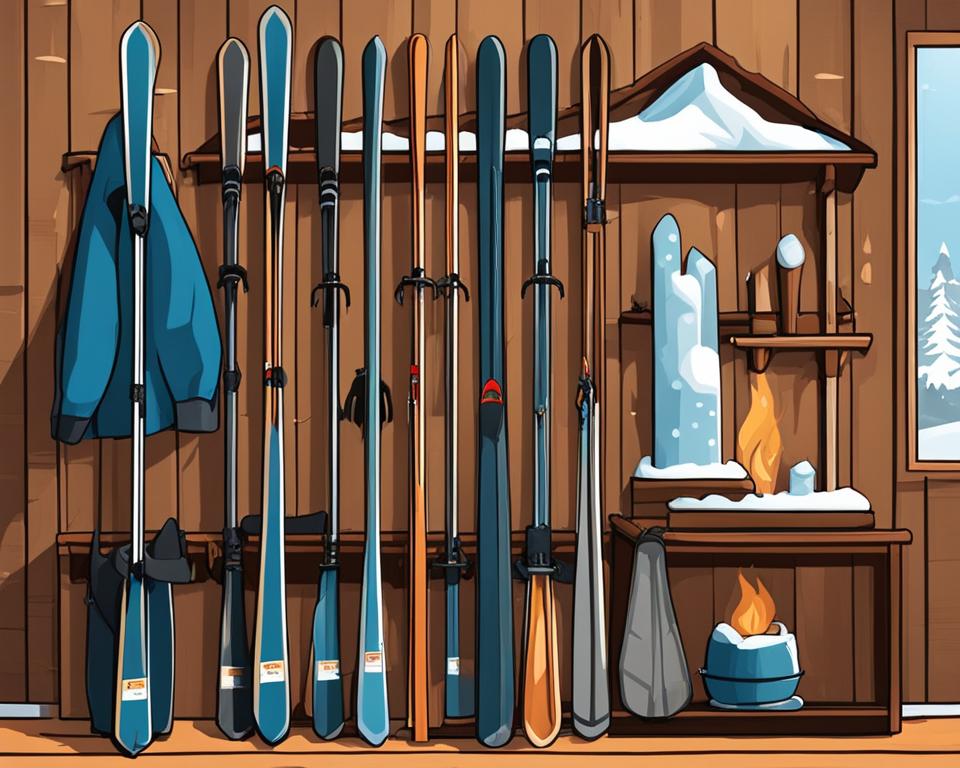Properly preparing your skis before bringing them indoors is essential for safe and convenient storage. Follow these steps to remove snow from your skis and ensure they are ready for indoor maintenance.
Key Takeaways:
- Removing snow from skis before bringing them indoors is crucial for safe and convenient storage.
- Use poles or tap the boots against the bindings to remove snow from the soles.
- Check the binding placement and align your boot properly before securing it.
- A ski scraper is an essential tool for removing snow and ice from your skis.
- Scrape off snow and ice from your skis during transitions to maintain performance.
How to Properly Put On Skis
Before hitting the slopes, it’s important to know how to properly put on your skis. This ensures a safe and enjoyable skiing experience. Follow these steps to put on your skis correctly:
- Remove any snow from the soles of your boots using your poles to scrape it off or by banging the backs of your boots against the bindings.
- Check the metal component at the back of the binding to ensure it is properly aligned and in good condition.
- Align the toe of your boot with the front part of the binding, making sure it is centered.
- Secure your heel into the rear binding, ensuring it is properly seated and locked in place.
- Properly fasten the binding to ensure a secure fit. This may vary depending on the type of binding you have, so refer to the manufacturer’s instructions.
By following these steps, you’ll have your skis securely on your feet and be ready to hit the slopes with confidence. It’s important to note that if you’re unsure about any step, seek assistance from a trained professional or ski instructor.
Tips for Ski Safety
As you put on your skis, it’s essential to prioritize safety. Here are some tips to keep in mind:
- Always check that your ski bindings are properly adjusted to your weight, height, and skiing ability.
- Ensure your ski boots are the correct size and fit snugly, providing the necessary support and control.
- Double-check that all buckles and straps on your boots are securely fastened.
- Wear appropriate ski goggles or sunglasses to protect your eyes from sun glare and debris.
- Use ski poles for balance and stability as you navigate the slopes.
Remember, putting on your skis properly and prioritizing safety are crucial for an enjoyable and injury-free skiing experience.
| Tip | Benefit |
|---|---|
| Remove snow from boot soles | Prevents slippage and ensures proper binding engagement |
| Check binding alignment | Ensures proper placement of boot and binding |
| Align toe with binding | Allows for secure fit and control |
| Secure heel in binding | Prevents accidental release and enhances stability |
| Fasten binding properly | Ensures secure attachment and prevents binding malfunction |
The Importance of Ski Scrapers
When it comes to ski maintenance, having the right tools can make all the difference. One such tool that should not be overlooked is the ski scraper. Ski scrapers are essential for removing snow and ice from your skis, ensuring optimal performance on the slopes.
Ski scrapers can be used in multiple ways to keep your skis in top condition. Firstly, they are great for clearing snow off the topsheets, making it easier to handle and transport your skis. Secondly, ski scrapers are handy for removing ice from the bases and bindings, improving glide and preventing any interference with your ski bindings. Additionally, ski scrapers can be used to dig out ice from the tech toes, ensuring proper functionality.
| Ski Scraper Uses | Benefits |
|---|---|
| Clearing snow off topsheets | Easier handling and transportation of skis |
| Removing ice from bases and bindings | Improved glide and binding functionality |
| Digging out ice from tech toes | Ensuring proper tech binding operation |
For optimal ice removal, it is recommended to cut the ski scraper at an angle to create a sharp point. This shape allows for more effective ice removal, ensuring that your skis are clean and ready for action.
But that’s not all – ski scrapers can also come in handy during ski waxing. They can be used to squeegee excess water out of ski skins and assist in removing any excess wax from the base of your skis. This makes ski scrapers a versatile tool that can be used for various ski maintenance tasks.
Remember, investing in a plastic ski scraper is a cost-effective way to prolong the life of your ski equipment and ensure that you’re always ready for your next adventure on the slopes.
So, don’t underestimate the importance of ski scrapers in your ski care routine. With their ability to remove snow, ice, and excess wax, ski scrapers are an indispensable tool for maintaining the performance and longevity of your skis.
Ski Maintenance During Transitions
During transitions on the slopes, proper care for your skis is crucial to ensure optimal performance and longevity. Here are some essential tips for maintaining your skis during ski transitions:
Clearing Snow and Ice
Before starting your transition, take a moment to remove any snow or ice that has accumulated on your skis. Use a ski scraper or your ski poles to clear the topsheets, bases, and bindings of any snow or ice. This will prevent additional weight and reduce the risk of damage to your skis during the transition. Taking a few seconds to clear off the snow can make a significant difference in your overall skiing experience.
Checking Ski Edges
During transitions, it’s also important to check the edges of your skis for any signs of damage or dullness. Inspect the edges visually and run your finger along the edges to ensure they are sharp and free from any burrs. If your ski edges need sharpening, address it promptly to maintain optimal ski performance. Sharp edges allow for better grip on the snow and enhance your control while skiing.
Inspecting Bindings
Another important aspect of ski maintenance during transitions is checking the bindings. Ensure that they are securely fastened and functioning properly. Look for any signs of wear or damage on the bindings, such as loose screws or cracks. If you notice any issues with your bindings, it’s crucial to have them inspected and repaired by a professional before hitting the slopes again.
By following these simple tips for ski maintenance during transitions, you can ensure that your skis remain in excellent condition and perform at their best. Taking a few extra moments to care for your skis during transitions will contribute to a smoother and safer skiing experience.

Ski Maintenance During Transitions Table
| Tip | Description |
|---|---|
| Clearing Snow and Ice | Use a ski scraper or poles to remove snow and ice from topsheets, bases, and bindings. |
| Checking Ski Edges | Inspect the edges visually and run your finger along them to ensure they are sharp and free from burrs. |
| Inspecting Bindings | Check that bindings are securely fastened and free from any signs of wear or damage. |
Tips for Storing Ski Equipment
Proper storage of your ski equipment is essential to maintain its quality and performance. By following these tips, you can ensure that your gear stays in top shape during the winter months.
Dry Your Boots and Liners
Before storing your ski boots, make sure they are completely dry. Moisture trapped inside the boots can lead to mold and unpleasant odors. Use a boot dryer or remove the liners to allow them to air dry thoroughly. This will help prevent any buildup of moisture that could damage the materials and affect the fit of your boots.
Clean and Wax Your Skis
Before storing your skis, it’s important to clean the bases to remove any dirt or debris that may have accumulated. Use a gentle cleaner or consider using the hot scraping method to effectively remove dirt and old wax. This will help prevent dirt from becoming embedded in the bases and affecting their performance. After cleaning, apply a fresh coat of wax to protect the bases during storage.
Protect From Pests
When storing your ski equipment, it’s important to protect it from mice and other pests. These critters can cause significant damage to your gear if left unchecked. Store your equipment in a location that is inaccessible to pests, such as a sealed container or a closed-off area in your home. Consider using natural deterrents like peppermint oil or mothballs to keep pests away from your gear.
| Tip | Action |
|---|---|
| Dry your boots and liners | Use a boot dryer or remove liners for thorough drying |
| Clean and wax your skis | Remove dirt and apply a fresh coat of wax |
| Protect from pests | Store in sealed containers and use natural deterrents |
By taking these steps to properly store your ski equipment, you can ensure that it remains in excellent condition and ready for your next skiing adventure. Don’t let improper storage ruin your gear. Take the time to care for it properly and enjoy a hassle-free winter season.

Maintaining Ski Equipment Off-Season
Proper maintenance of your ski equipment during the off-season is crucial for its longevity and performance. By taking care of your gear during the months when you’re not hitting the slopes, you can ensure that it’s in great condition when the next ski season arrives. Here are some essential tips for off-season ski equipment maintenance:
- Clean and dry your ski boots: Before storing your ski boots, make sure to clean them thoroughly and allow them to dry completely. Use a damp cloth to remove any dirt or residue, and let them air dry in a well-ventilated area. This helps prevent mold and keeps your boots fresh for the next ski season.
- Inspect and repair: Take the time to inspect your skis and bindings for any signs of damage or wear. Check the edges for rust or corrosion, and address it promptly with edge sharpening if needed. If you notice any cracks or loose parts on your bindings, consider taking them to a professional for repair or replacement.
- Store your equipment properly: When storing your ski equipment, it’s important to keep it in a cool, dry place. Avoid storing your gear in a damp basement or garage where moisture can cause damage. Use a ski bag or a dedicated ski storage rack to keep your skis and poles organized and protected.
- Prepare for next season: Use the off-season to prepare your equipment for the next ski season. Consider waxing your skis to protect the bases and keep them in optimal condition. If you’re not comfortable doing it yourself, take your skis to a professional ski shop for waxing and tuning.
Remember, proper off-season maintenance ensures that your ski equipment stays in top shape and performs well when you’re ready to hit the slopes again. By following these tips, you can enjoy many seasons of great skiing with your well-maintained gear.
| Benefits of Off-Season Ski Equipment Maintenance | How to Achieve It |
|---|---|
| Extended equipment lifespan | Regular inspections and repairs |
| Improved performance on the slopes | Proper storage in a cool, dry place |
| Reduced risk of damage or failure | Thorough cleaning and drying of boots |
| Cost savings on repairs or replacements | Waxing and tuning before storing |
Conclusion
Proper maintenance of your ski equipment is crucial for its longevity and optimal performance. By following the steps outlined in this guide, you can ensure that your skis are well-taken care of, both during and after the ski season.
Removing snow from your skis before bringing them indoors is essential to prevent moisture buildup and potential damage. Remember to scrape off any snow or ice from the topsheets and bases during transitions to maintain your ski’s performance on the slopes.
When storing your ski equipment, make sure your boots and liners are completely dry to prevent mold and odor. Taking the time to clean the bases of your skis and wax them will protect them from dirt and prolong their lifespan. Finally, store your equipment in a safe location to protect it from pests.
With proper snow removal, indoor maintenance, and storage practices, your ski equipment will be ready for your next winter adventure. By caring for your skis, you’ll enjoy a hassle-free skiing experience and ensure the longevity of your valuable equipment.
FAQ
How do I remove snow from the soles of my ski boots?
You can use your poles to scrape off the snow or bang the backs of your boots against the bindings.
How do I ensure proper placement of the binding?
Check the metal component at the back of the binding to ensure it is aligned correctly.
Why is a ski scraper important?
Ski scrapers are essential for removing snow and ice from your skis, clearing topsheets, and assisting in waxing.
How can I remove ice effectively with a ski scraper?
By cutting the scraper at an angle to create a sharp point, you can achieve more effective ice removal.
Why is it important to remove snow and ice during transitions?
Removing snow and ice during transitions prevents added weight from affecting your performance and reduces the risk of damage to your skis.
How can I ensure my ski boots and liners are dry for storage?
Use a boot dryer or remove the liners for thorough drying to prevent moisture buildup and prolong the life of your boots.
How do I clean the bases of my skis before storage?
Use a gentle cleaner or the hot scraping method to remove dirt and wax from the bases before storing to prevent dirt from becoming embedded in the wax.
How can I protect my ski equipment from pests?
Store your equipment in a location where it is protected from mice and other pests.
How should I maintain my ski equipment during the off-season?
Regularly check for signs of rust on the edges of your skis and address it promptly with edge sharpening. Keep your boots and liners clean and dry to prevent mold and odor. Wash your ski parka and pants with a product that restores water repellency and breathability.
Why is proper snow removal from skis important?
Proper snow removal ensures the longevity and performance of your ski equipment, and it allows for safe storage and optimal performance when the next ski season arrives.


